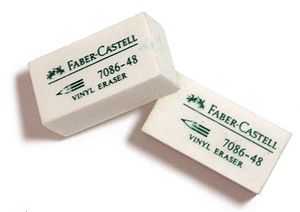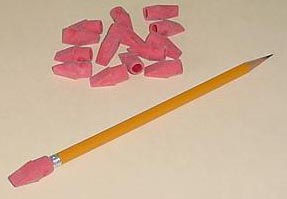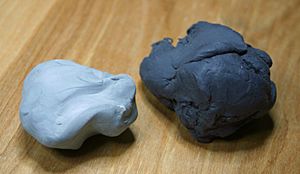Eraser facts for kids

An eraser is a tool made from rubber that is used to get rid of marks made from a pencil, or some types of pen. Another kind of eraser is made of felt and is used to remove chalk marks from a blackboard. Some may also be automatically be attached to a pencil, or could be bought to be shoved on a top of a pencil. You can use the eraser by rubbing the mistake and it will slowly clear away. All erasers will produce some dust called debris after rubbing and it will usually be black as it cleared away the pencil marks. Some erasers produce a lot of dust while some produce dust that all stick together. There are some good-quality erasers which are very soft and can erase easily, while some are very hard, and a lot of rubbing is needed. The classic pink eraser is made for smaller, lighter errors, whereas a thick, white eraser is made for bigger and/or darker marks.
Contents
Types

Pencil or cap erasers
Originally made from natural rubber, but now usually from cheaper SBR, this type contains mineral fillers and an abrasive such as pumice with a plasticizer such as vegetable oil. They are relatively hard (in order to remain attached to the pencil) and frequently coloured pink.
Artist's gum eraser
The stylized word "Artgum" was first used in 1903 and trademarked in the USA in 1907. That type of eraser was originally made from oils such as corn oil vulcanized with sulfur dichloride although may now be made from natural or synthetic rubber or vinyl compounds. It is very soft yet retains its shape and is not mechanically plastic, instead crumbling as it is used. It is especially suited to cleaning large areas without damaging paper. However, they are so soft as to be imprecise in use. The removed graphite is carried away in the crumbles, leaving the eraser clean, but resulting in a lot of eraser residue. This residue must then be brushed away with care, as the eraser particles are coated with the graphite and can make new marks. Art gum erasers are traditionally tan or brown, but some are blue.
Vinyl erasers
Good quality plasticized vinyl or other "plastic" erasers, originally trademarked Mylar in the mid-20th century, are softer, non-abrasive, and erase cleaner than standard rubber erasers. This was because the removed graphite did not remain on the eraser as much as rubber erasers, but was instead absorbed onto the discarded vinyl scraps. Being softer and non-abrasive, they were less likely to damage canvas or paper. Engineers favor this type of eraser for work on technical drawings due to their gentleness on paper with less smearing to surrounding areas. They often come in white and can be found in a variety of shapes. More recently, very low-cost erasers are manufactured from highly plasticized vinyl compounds and made in decorative shapes.
Kneaded erasers
Kneaded erasers have a plastic consistency and are common to most artists' standard toolkit. They can be pulled into a point for erasing small areas and tight detail erasing, molded into a textured surface and used like a reverse stamp to give texture, or used in a "blotting" manner to lighten lines or shading without completely erasing them. They gradually lose their efficacy and resilience as they become infused with particles picked up from erasing and from their environment. They are not suited to erase large areas because of their tendency to deform under vigorous erasing.
Poster putty
Commonly sold in retail outlets with school supplies and home improvement products, this soft, malleable putty appears in many colours and under numerous brand names. Intended to adhere posters and prints to walls without damaging the underlying wall surface, poster putty works much the same as traditional kneaded erasers, but with a greater tack and in some circumstances, lifting strength. Poster putty does not erase so much as lighten by directly pulling particles of graphite, charcoal or pastel from a drawing. In this regard, poster putty does not smudge or damage work in the process. Repeatedly touching the putty to a drawing pulls ever more medium free, gradually lightening the work in a controlled fashion. Poster putty can be shaped into fine points or knife edges, making it ideal for detailed or small areas of work. It can be rolled across a surface to create visual textures. Poster putty loses its efficacy with use, becoming less tacky as the material grows polluted with debris and oils from the user's skin.
Electric erasers
The electric eraser was invented in 1932 by Arthur Dremel of Racine, Wisconsin, USA. It used a replaceable cylinder of eraser material held by a chuck driven on the axis of a motor. The speed of rotation allowed less pressure to be used, which minimized paper damage. Originally standard pencil-eraser rubber was used, later replaced by higher-performance vinyl. Dremel went on to develop an entire line of hand-held rotary power tools.
Fibreglass erasers
A fibreglass eraser, a bundle of very fine glass fibres, can be used for erasing and other tasks requiring abrasion. Typically the eraser is a pen-shaped device with a replaceable insert with glass fibres, which wear down in use. The fibres are very hard; in addition to removing pencil and pen markings, such erasers are used for cleaning traces on electronic circuit boards to facilitate soldering, removing rust, and many other applications. As an example of an unusual use, a fibreglass eraser was used for preparing an archaeological fossil embedded in a very hard and massive limestone.
Other
Felt chalkboard erasers or blackboard dusters are used to erase chalk markings on a chalkboard. Chalk writing leaves light-coloured particles weakly adhering to a dark surface (e.g., white on black, or yellow on green); it can be rubbed off with a soft material, such as a rag. Erasers for chalkboards are made, with a block of plastic or wood, much larger than an eraser for pen or pencil, with a layer of felt on one side. The block is held in the hand and the felt rubbed against the writing, which it easily wipes off. Chalk dust is released, some of which sticks to the eraser until it is cleaned, usually by hitting it against a hard surface.
Various types of eraser, depending upon the board and the type of ink used, are used to erase a whiteboard.
Dedicated erasers that are supplied with some ballpens and permanent markers are intended only to erase the ink of the writing instrument they are made for; sometimes this is done by making the ink bond more strongly to the material of an eraser than the surface it was applied to.
Images for kids
See also
 In Spanish: Goma de borrar para niños
In Spanish: Goma de borrar para niños





